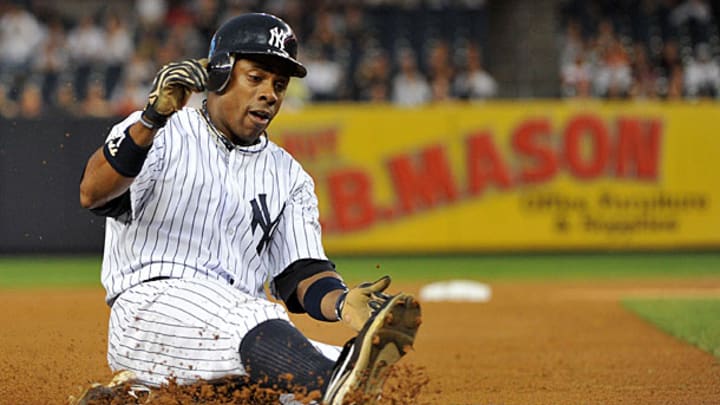Mets take big risk in handing Curtis Granderson four-year, $60M contract

Curtis Granderson is staying in New York but moving to Queens after four seasons in the Bronx. (Getty Images)

The Mets have come to terms with former Yankees centerfielder Curtis Granderson on a four-year contract worth $60 million. It is the fourth-richest deal agreed to this offseason after those given to Robinson Cano (10 years, $240 million with the Mariners), Jacoby Ellsbury (seven years, $153 million with the Yankees) and Brian McCann (five years, $85 million with the Yankees). Like those deals, Granderson's carries the additional cost of draft pick compensation, though the Mets' first-round pick, the 10th overall, is protected.
The Mets are showing considerable confidence in Granderson's ability to bounce back from an injury-plagued 2013 season and to put up big numbers outside of Yankee Stadium, which is especially favorable for lefthanded home run hitters like him. There's at least one more important reason why Granderson may have a tough time living up to his new deal: New York will slot him in rightfield -- it signed centerfielder Chris Young to a one-year, $7.25 million contract last month -- where the standard for offensive performance is higher than it is in center. In 2013, the average major league centerfielder and rightfielder produced nearly identical batting averages and OPS marks (.261 and .328 for the former compared to .266 and .329 for the latter). The difference came in the power department: centerfielders slugged .402 and hit 459 home runs compared to a .431 SLG and 640 homers for rightfielders.
The Yankees had intended to move Granderson to an outfield corner this past season, but he twice suffered broken bones on hit by pitches, once in his first spring training at-bat and then just eight games after his return in late May. As a result, his 2013 season didn't start in earnest until August. He was rotated through all three outfield positions and designated hitter until Brett Gardner suffered a season-ending oblique strain in mid-September, handing centerfield back to Granderson. The defensive metrics from his last two full seasons, 2011 and '12, suggest that the time has indeed come for him to move to a corner, where he has made just 23 starts in his career.
[si_video id="video_A4B2C1F0-066A-BD16-EBE5-C978C5B52C25" height="470"]
Granderson's defensive regression should come as no surprise given that he will be 33 in March. The biggest question will be whether or not he can remain an elite power hitter. Granderson averaged 42 home runs in 2011 and '12, but his home run rate in 2013 was barely above league average and he received a considerable boost during his four years with the Yankees from his home ballpark. From 2011 to 2013, Yankee Stadium tied Coors Field as the easiest place for lefties to hit home runs in, according to the park factors in the 2013 Bill James Handbook. Prior to his arrival in New York, Granderson's career high in home runs was 30, and in his two 40-homer seasons in the Bronx, he averaged one home run every 14.1 plate appearances at home and one every 19.2 plate appearances on the road.
Of equal if not greater concern is Granderson's falling batting average. With the exception of 2011, when he turned in an MVP-quality season despite hitting .262, Granderson's average has dropped every year since 2007, with his .232 mark in 2012 falling below his .247 in 2010 despite the "spike" in the season in between. Granderson has hit just .231 over the last two years, and while his low average in 2012 could be blamed on bad luck on balls in play, his .229 mark this past season came despite a representative .302 BABIP. Granderson also strikes out a lot (a career high 195 times in 2012 with a similar rate in his abbreviated 2013) and hits a lot of fly balls. The move from Yankee Stadium to Citi Field could result in more of his fly balls staying in the ballpark and becoming outs, thus increasing his difficulty in reversing that downward trend in batting average.
Those low batting averages drag down Granderson's overall production. He has power and patience, but not enough to overcome a .230 average. Yankees hitting coach Kevin Long fixed Granderson's career-long difficulties with lefthanded pitching in late 2010, which led to his monster 2011 campaign and that small spike in batting average, but while Granderson has continued to have success against lefties, showing almost no platoon split over the last two years combined, that gain has failed to arrest the decline of his batting average.
There's thus a great deal of risk in this deal for the Mets. They have signed a player in apparent decline on both sides of the ball for his age-33 to -36 seasons, will put him in a more difficult hitting environment and are doing so at the cost of $60 million and their second-round draft pick. Given that the Mets are a rebuilding team looking ahead to the 2015 and '16 seasons and the return of ace Matt Harvey, who will miss 2014 following Tommy John surgery, Granderson seems like an odd fit on the field, even if he should be a great influence on the many young players in the clubhouse.
